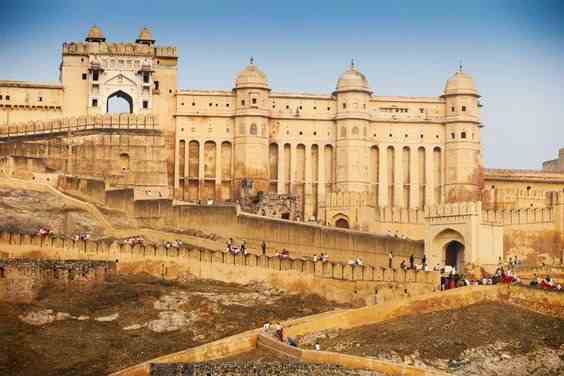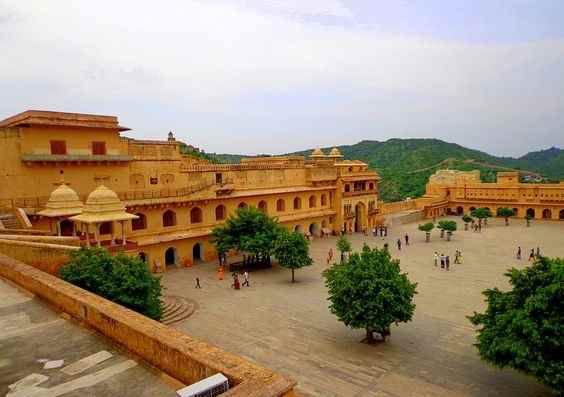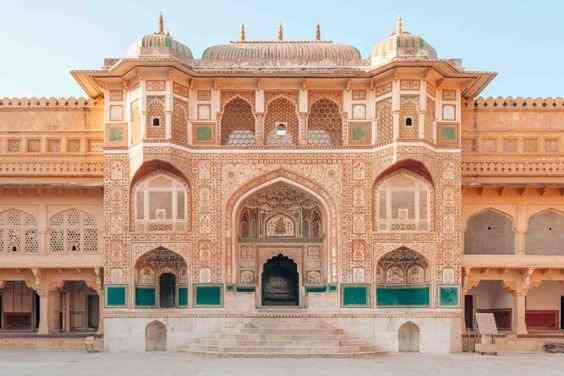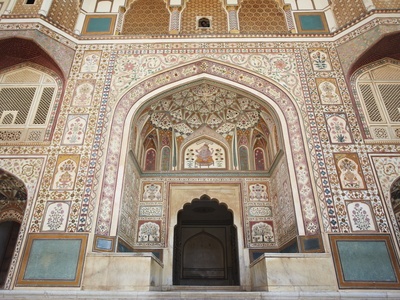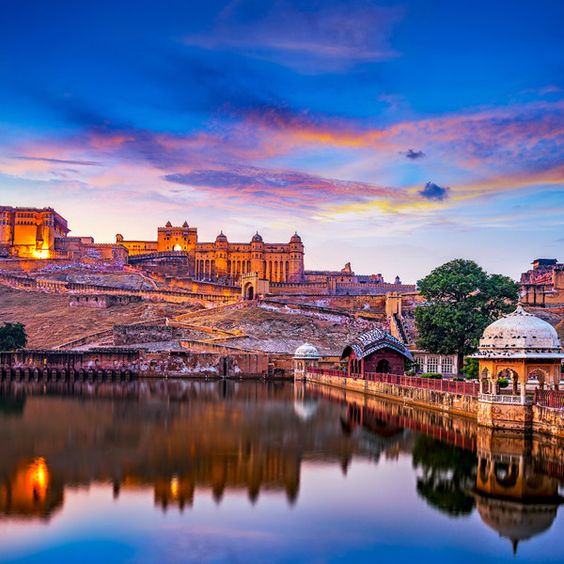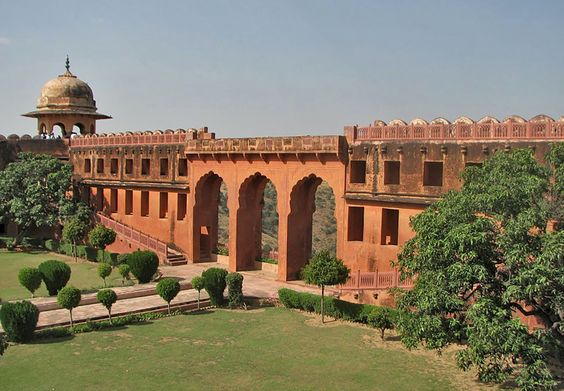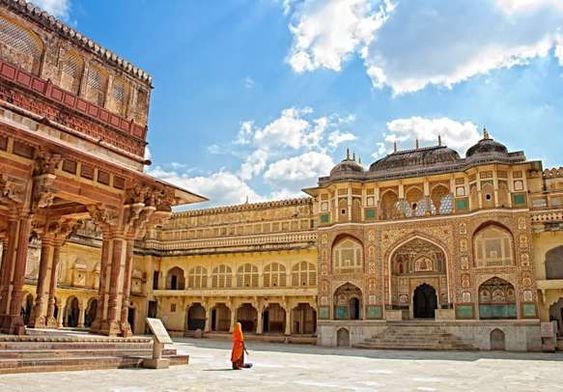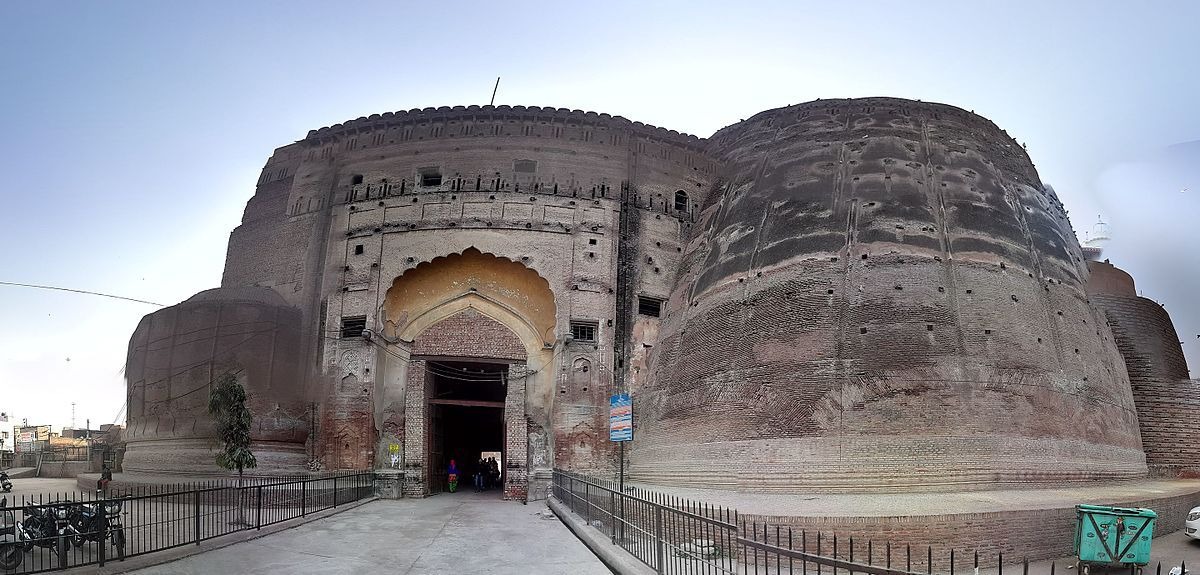Dive into history at Amber Fort, Jaipur – Your journey begins here.
Introduction To Amer Fort
In terms of India’s rich cultural and historical heritage, Amer Fort Jaipur is one of the best places To Visit. This fort is situated at the top of the Aravali Range. Since the 16th century, Its surface represented the royal beauty of the Amber Fort and it is the place to visit near Amer Fort Jaipur. The captivating style of architecture developed by the Rajput and the Mughals is a sight to be seen.
History of the Amber Fort
Amber Fort also called “Amer Fort,” was first built in 967 AD by Raja Alan Singh, and Amer Fort’s history is connected to its roots in the Chanda Clan of Meenas.
In 1592, under the leadership of Raja Man Singh (Raja of Kachwaha), a well-known Rajput ruler, the fort underwent a period of transformation.
Through The next 150 years, Amer Fort Palace went through major changes and was further enhanced with spectacular designs by Rajputana successors like Sawai Jai Singh, which led to the notable Amer Fort Place of today.
For the time being, the greatest achievement came when Amer Fort, Amer Ka Killa was declared a World Heritage Site by UNESCO in 2013.
Places To See in Amber Fort ( Amer Fort )
Sheesh Mahal
King Man Singh constructed the Sheesh Mahal Amer Fort palace in the 16th century, and it was completed in the year 1727. One of the most visited places in Amer Fort Jaipur is Sheesh Mahal, also known as the Mirror Palace. This Palace is a stunning creation of glass and expensive marble, adorned with intricate hand-painted designs. After that, this year marked the foundation year of Jaipur.
Ganesh Pol Entrance
As you step through the imposing Ganesh Pol Amer Fort Jaipur, an exquisite world of royal splendor unfolds before your eyes. Serving as the main entrance to the private palaces of the Maharajas, this architectural masterpiece is a testament to the unparalleled brilliance of Rajput’s design.
The Ganesh Pol at Amer Fort, also known as Ganesh Gate, is not merely a Ganesh Pol gateway but a grand proclamation of the prosperity that awaits within. Intricately carved with images of gods and goddesses, every inch of this structure tells a story of devotion, power, and artistic finesse.
The carvings on the Ganesh Pol Gateway Jaipur are a breathtaking showcase of Rajput aesthetics. Each figure is meticulously crafted, depicting the divine in a way that transcends mere stone and mortar. The gods and goddesses adorning the gate serve as protectors, welcoming visitors into the realm of the Maharajas with divine blessings.
The central figure of Lord Ganesh Mandir, the remover of obstacles, takes center stage, symbolizing the auspicious beginning of the journey through the Amber Palace ( Amer ). The craftsmanship is so detailed that one can almost feel the spiritual energy emanating from the stone carvings, creating an atmosphere of reverence and awe.
The architectural brilliance of the Amer Fort Ganesh Pol extends beyond its religious depictions. The gate is adorned with delicate jali work, allowing a play of light and shadow that adds an ethereal quality to the structure. As sunlight filters through the intricately carved screens, it creates a mesmerizing dance of patterns on the ground, adding to the sensory richness of the entrance.
What makes the Ganesh Pol Gateways truly remarkable is their role as a transition point from the external world to the private sanctuaries of the Maharajas. It marks the beginning of a journey into a realm of luxury, where every corner echoes with the whispers of history and regality.
As you pass through the Ganesh Pol Entrance, it’s impossible not to marvel at the skill of the artisans who brought this masterpiece to life. The gate stands as a living legacy, a tribute to the cultural richness and artistic prowess of the Rajput era. Each visit becomes a pilgrimage through time, allowing modern-day visitors to connect with the heritage and grandeur of Rajasthan.
In conclusion, the Ganesh Pol at Amber Fort Jaipur is not just a gateway; it’s a portal to a world of magnificence. Its intricate carvings and divine symbolism make it a prime example of Rajput architectural brilliance, inviting all who enter to be a part of a timeless journey through history and culture.
Diwan-e-Aam: The Hall of Public Audience
Imagine standing in the very hall where the Maharaja addressed the common people. Diwan–e–Aam Jaipur and Diwan–e–khas, with their decorated pillars and grandeur, served as a space for the ruler to connect with his subjects. The hall resonates with the echoes of history, where proclamations were made and the concerns of the public were heard. Today, visitors can immerse themselves in this historical atmosphere, imagining the vibrant gatherings that once took place within these hallowed walls.
The Diwan-e-Aam Hall of Public Audience, with its spacious layout, allowed for a democratic engagement between the ruler and the people. The Mughal penchant for symmetry and grandeur is evident in every corner, providing a visual feast for those who appreciate the artistry of a bygone era.
Exploring the Amer Fort Surroundings
Maota Lake, Jaipur
As you wander through the expansive grounds of Amber Fort, you’ll discover the ethereal beauty of Maota Lake in Amber Fort—a serene oasis that enhances the fort’s charm. The still waters of the lake reflect the grandeur of the fort, creating a mesmerizing scene that captivates every visitor. Nestled against the backdrop of the Aravalli Range, Maota Lake Jaipur is more than just a body of water; it’s a vital part of the fort’s allure.
Visitors are invited to indulge in the tranquility by taking a leisurely boat ride on Maota Lake. Drifting on the calm waters provides a unique perspective of Amber Fort in Jaipur’s magnificent architecture. As you gently glide along, the reflection of the fort’s intricate details dances on the lake’s surface, offering a visual spectacle that is both enchanting and unforgettable.
Jaigarh Fort Museum: A Historical Symbiosis
Connected to Amer Fort like a companion steeped in history, Jaigarh Fort stands proudly on the same hill, sharing the tales of centuries gone by. More than just a neighboring structure, Jaigarh Fort Jaipur Treasure served as a strategic companion, offering military support to Amber Fort during times of historical significance.
Exploring the Jaigarh Fort to Amer Fort distance in a single visit is a journey through time. Jaigarh Fort’s rugged battlements and expansive views complement Amber Fort’s regal architecture. The interconnected history of these two forts provides visitors with a comprehensive understanding of the region’s rich and complex past. Each step within these historical walls whispers stories of valor, defense, and the vibrant cultural tapestry that has shaped the land.
Whether you’re strolling along the pathways of Amber Fort or standing atop the ramparts of Jaigarh Fort Cannon, the sense of historical symbiosis is palpable. It’s a reminder that these forts, though distinct in their identities, share an inseparable bond, contributing to the fascinating narrative of Jaipur’s royal heritage.
So, as you embark on your exploration of Amber Fort Jaipur and its surroundings, let the tranquility of Maota Lake and the historical embrace of Jaigarh Fort Treasure transport you to an era where every stone has a story to tell.
Amber Fort Jaipur Rich Cultural Heritage
Amber Fort Palace Also known as “Amer Ka Killa” stands as more than a mere architectural marvel; it embodies a vibrant tapestry woven with the threads of both Rajput and Mughal cultures. It isn’t just a silent witness to history; it pulsates with life during traditional events and festivals, providing a unique opportunity for visitors to immerse themselves in the rich, colorful celebrations that have echoed through the region for centuries.
The fusion of Rajput and Mughal influences is evident in every nook and cranny of the Fort Amer in Jaipur. From the intricate carvings on the walls to the design of the palaces, Amber Fort Palaces encapsulates the artistic and cultural exchange between these two prominent dynasties. Walking through its courtyards is akin to stepping into a living museum where the past gracefully intertwines with the present.
During traditional events and festivals, Amer Fort Jaipur Architecture takes on a new persona. The air is charged with excitement as the vibrant traditions of Rajasthan unfold. Visitors have the privilege of witnessing captivating performances, including traditional dances, music, and cultural rituals. The Amer Fort becomes a canvas painted with the vivid hues of local attire, creating a spectacle that transports onlookers to an era where grandeur and tradition coexist.
One such festival that brings Amber Fort History to life is the Teej Festival. Celebrated with enthusiasm and fervor, this festival pays homage to the goddess Parvati and is marked by processions, folk music, and dance. The fort’s courtyards reverberate with the rhythmic beats of traditional instruments, and the aroma of local delicacies wafts through the air, creating an immersive sensory experience for visitors.
Another noteworthy celebration is Diwali, the Festival of Lights. Amber Palace ( Amer ) Inside, adorned with countless lamps and decorations, becomes a luminous spectacle against the darkening sky. The ambiance is joyous, and the echo of laughter and celebrations permeates the surroundings, offering a glimpse into the cultural significance of this auspicious occasion.
Beyond the grand festivals, Amber Fort Jaipur Light and Sound Show host cultural events that showcase the region’s artistic prowess. Local artisans often gather to exhibit their craft, providing visitors with an opportunity to witness the creation of traditional artifacts and textiles. This interaction not only adds depth to the cultural experience but also supports the local communities that contribute to the fort’s vibrant atmosphere.
In essence, Amber Fort Jaipur is a living testament to the enduring legacy of Rajasthan’s cultural heritage. Its walls echo with the stories of valor, love, and the harmonious coexistence of diverse influences. For those seeking more than just architectural marvels, Amer Fort ( Amber Fort ) Jaipur in Rajasthan unfolds as a captivating journey through time, offering a profound connection to the cultural roots that have shaped this magnificent fortress.
Best Time to Visit Amer Fort
When planning your visit to the enchanting Amber Fort and Palaces, timing is key to ensuring an unforgettable experience. Understanding the climate and choosing the right season can significantly enhance your exploration of this historical marvel.
The best month to visit the amber fort is during the winter months, from October to March. This period offers a climate that is not only mild but also pleasantly cool, creating ideal conditions for an immersive journey through the fort’s captivating history.
The winter season is the right time to visit Amber Fort in Jaipur, Rajasthan, which brings relief from the scorching heat that dominates the region during the summer months. With daytime temperatures ranging from comfortable to mildly cool, visitors can explore the fort without the discomfort of extreme heat. Beyond the agreeable weather, visiting Amer Fort Palaces during the winter also allows you to avoid the peak tourist seasons. This strategic timing ensures a more intimate and personal encounter with the fort’s rich history. The reduced crowd allows for a leisurely exploration, allowing you to absorb the intricate details of the Amer Fort Architecture and immerse yourself in the cultural ambiance without the hustle and bustle accompanying peak times.
Whether you are a history enthusiast, a photography buff, or a casual traveler, the winter months provide an optimal backdrop for your visit. The clear skies and mild temperatures create an atmosphere that enhances every aspect of the Amber Fort experience.
In conclusion, if you’re considering a visit to Amber Fort which is known as “Amer Ka Killa in Jaipur”, plan it during the winter months for a perfect blend of pleasant weather, reduced crowds, and an opportunity to delve deep into the Amer Fort historical significance of this architectural masterpiece. Your journey through time and majesty awaits the Best Places To Visit in Jaipur in the crisp, refreshing air of the winter season.

